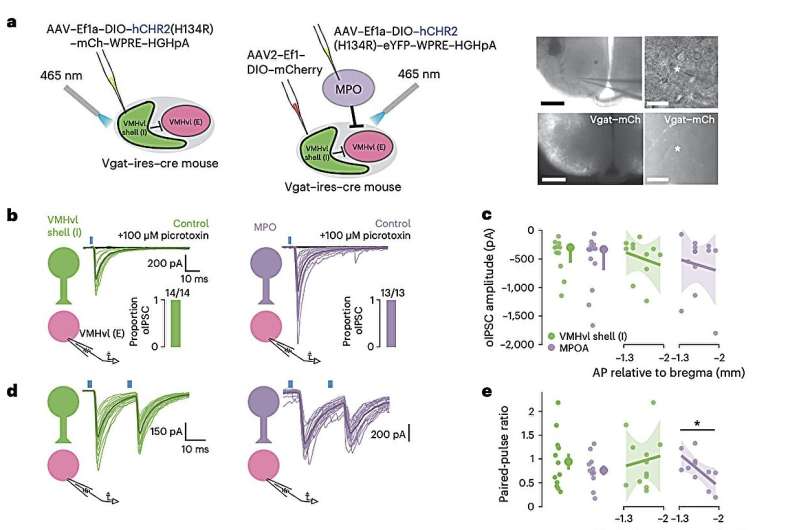March 11, 2024 feature
This article has been reviewed according to Science X's editorial process and policies. Editors have highlighted the following attributes while ensuring the content's credibility:
fact-checked
peer-reviewed publication
trusted source
proofread
Study offers insights into neural mechanisms involved in progression from aggressive motivation to action

The social behaviors of humans and animals often unfold over two distinct phases, namely a motivational and an action phase. The first of these phases entails instinctual and reward-seeking mental states, characterized by sexual or aggressive drives to perform specific actions. The second phase entails acting on these motivations and drives.
While many neuroscience studies investigated social behaviors and these two "phases," their underlying neural underpinnings are not yet fully understood. A deeper understanding of these phases, particularly the processes behind the progression from motivation to action, could offer valuable insight into mental health disorders marked by dysregulated social interactions, such as aggressive tendencies or hypersexual behaviors.
Researchers at Princeton Neuroscience Institute recently carried out a study investigating the neural underpinnings of the progression from aggressive motivation to action. Their paper, published in Nature Neuroscience, highlights the potential role of neurons in a subregion of the hypothalamus in encoding the sequence leading from hostile intentions to aggressive behaviors.
"We show that neurons in the ventromedial hypothalamus ventrolateral area (VMHvl) of mice encode the temporal sequence of aggressive motivation to action," Tomohito Minakuchi, Eartha Mae Guthman and their colleagues wrote in their paper. "The VMHvl receives local inhibitory input (VMHvl shell) and long-range input from the medial preoptic area (MPO) with functional coupling to neurons with specific temporal profiles."
The VMHv1 is a nucleus located in the front-middle part of the hypothalamus, which has been previously linked to the regulation of glucose, as well as various motivation-driven behaviors, including those aimed at eating to stop hunger, sexually driven behaviors and other social behaviors.
As part of their study, Minakuchi, Guthman and their colleagues set to specifically explore the role of neurons in the VMHv1 in aggression-driven behaviors. To do this, they carried out a series of experiments on mice, during which the male mice were trained to complete a task and were rewarded by the ability to freely express their aggression towards other male mice.
The researchers observed the behavior of the mice and monitored the activity of individual neurons in the VMHv1 region throughout the experiments. Their analyses unveiled a relationship between the patterns of activity of neurons in this region and the progression from aggressive motivation to action.
"Encoding models reveal that during aggression, VMHvl shellvgat+ activity peaks at the start of an attack, whereas activity from the MPO–VMHvlvgat+ input peaks at specific interaction endpoints," Minakuchi, Guthman and their colleagues wrote. "Activation of the MPO–VMHvlvgat+ input promotes and prolongs a low motivation state, whereas activation of VMHvl shellvgat+ results in action-related deficits, acutely terminating attack. Moreover, stimulation of MPO–VMHvlvgat+ input is positively valenced and anxiolytic."
This recent work by Minakuchi, Guthman and their collaborators gathered new insight about the neural underpinnings of the shift from aggressive motivation to aggressive behavior in mice.
In the future, if validated in primates, humans, and other mammals, these findings could contribute to the understanding of psychiatric and behavioral disorders marked by anti-social tendencies, particularly by the poor inhibitory control of aggressive impulses.
More information: Tomohito Minakuchi et al, Independent inhibitory control mechanisms for aggressive motivation and action, Nature Neuroscience (2024). DOI: 10.1038/s41593-023-01563-6
© 2024 Science X Network


















